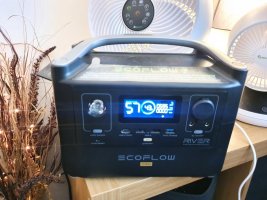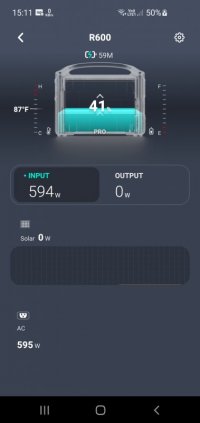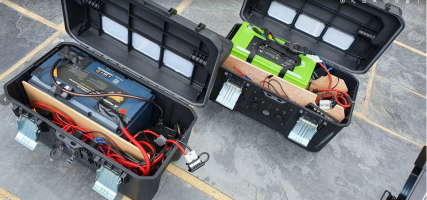Last night SWMBO asked if I could return clean bedding, etc, to our caravan after it was brought home following a 3 week holiday. I was told that Mother-In-Law was coming around and the utility room looked untidy! (God forbid!)
Anyway, I was keen to visit the van in storage as last week i installed two Lifepo4 batteries and was unable to configure the mains chargers battery profile or install a Victron Smart Battery Sense (To avoid issues in the event of a charging fault/freezing conditions). This was because there is no mains power supply in the storage compound. During the week I had a bright idea to plug in my "Ecoflow River Pro" to the EHU to simply provide enough power to configure the VE Network and I was keen to get this done.
So, I plugged the EHU cable into the Ecoflow and configured what I wanted. I then got a bit nerdy, as I thought I'd see what would happen if I let the the Ecoflow discharge itself into my battery bank (which was discharged by 62.4 Ahat the time. The Ecoflow was at 100%
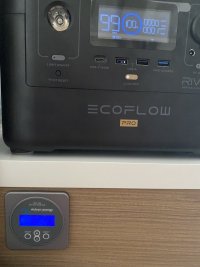
Ecoflow claim that the River Pro has a capacity of 720Wh so I was intested to see what this would equate to after all of the inefficiencies of the builtin inverter and other losses through charging.
I turned off the MPPT to stop any solar assistance to see what would happen and let my mains charger go for it. The charger is a 30A Victron Phoenix smart charger and it was clear that whilst the inefficiency was significant it was much less than I expected:
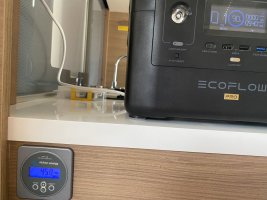
The Ecoflow was chucking out around 540W and the 220Ah lithium battery bank were accepting around 31A.
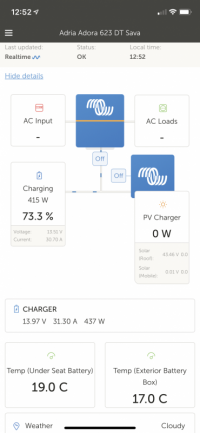
Eventually the Ecoflow fully discharged itself and the real life test results were in!
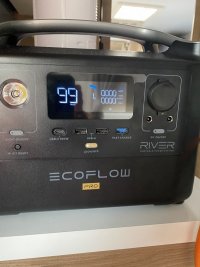

The test took just over an hour with the charger running at max capacity (30A) and at the end of the test the batteries had recovered 44.9Ah. (-62.4Ah to -17.5Ah.)
So, assuming a nominal voltage of 12.8V, I managed to whack 575Wh into my leisure batteries from a fully charged EcoFlow River Pro. This equates to a loss of around 20%.
I turned the MPPT charging back on once I had completed the test.
Incidentally, my Mother-In-Law was still at my house when I returned home. She is coming again next week, so I may re-run my experiment with the charger throttled back from 30A to 10A to see if efficiency improves!
Anyway, I was keen to visit the van in storage as last week i installed two Lifepo4 batteries and was unable to configure the mains chargers battery profile or install a Victron Smart Battery Sense (To avoid issues in the event of a charging fault/freezing conditions). This was because there is no mains power supply in the storage compound. During the week I had a bright idea to plug in my "Ecoflow River Pro" to the EHU to simply provide enough power to configure the VE Network and I was keen to get this done.
So, I plugged the EHU cable into the Ecoflow and configured what I wanted. I then got a bit nerdy, as I thought I'd see what would happen if I let the the Ecoflow discharge itself into my battery bank (which was discharged by 62.4 Ahat the time. The Ecoflow was at 100%

Ecoflow claim that the River Pro has a capacity of 720Wh so I was intested to see what this would equate to after all of the inefficiencies of the builtin inverter and other losses through charging.
I turned off the MPPT to stop any solar assistance to see what would happen and let my mains charger go for it. The charger is a 30A Victron Phoenix smart charger and it was clear that whilst the inefficiency was significant it was much less than I expected:

The Ecoflow was chucking out around 540W and the 220Ah lithium battery bank were accepting around 31A.

Eventually the Ecoflow fully discharged itself and the real life test results were in!


The test took just over an hour with the charger running at max capacity (30A) and at the end of the test the batteries had recovered 44.9Ah. (-62.4Ah to -17.5Ah.)
So, assuming a nominal voltage of 12.8V, I managed to whack 575Wh into my leisure batteries from a fully charged EcoFlow River Pro. This equates to a loss of around 20%.
I turned the MPPT charging back on once I had completed the test.
Incidentally, my Mother-In-Law was still at my house when I returned home. She is coming again next week, so I may re-run my experiment with the charger throttled back from 30A to 10A to see if efficiency improves!

